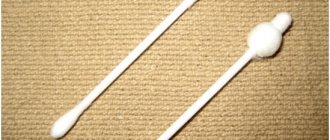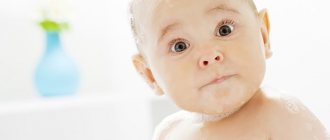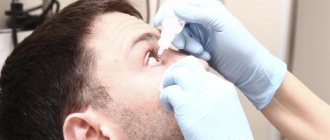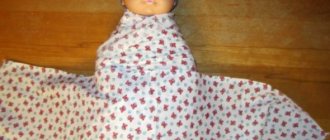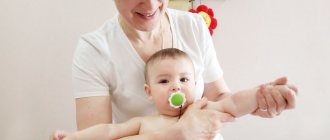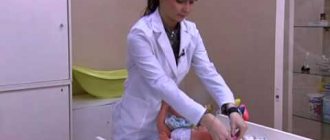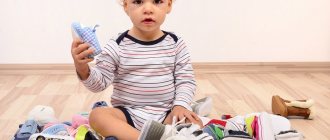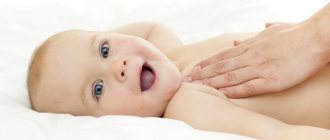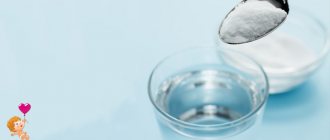Causes of eye suppuration in a baby
Eye diseases that cause purulent discharge from the visual organs in infants:
- Dacryocystitis is a blockage of the lacrimal canal. If the protective film does not break, a plug forms and an infection begins. Dacryocystitis is manifested by swelling, lacrimation, discharge of purulent contents when lightly pressing on the inner corner of the eye.
- Conjunctivitis is the most common cause of suppuration. The disease manifests itself as redness of the conjunctiva, swelling, and increased body temperature. The development of conjunctivitis is influenced by streptococci, staphylococci and adenoviruses.
- Gonococcal infection.
- ARVI, influenza, measles, herpes and adenovirus cause the appearance of such a symptom. They affect the entire functioning of the body, the eyes are the first to suffer, since they are the most sensitive to infections.
- Allergies always cause general discomfort. Manifested by purulent discharge, lacrimation, swelling of the respiratory tract and photophobia.
Preparing to wipe and wash your baby's eyes
Preparation involves washing your hands with antibacterial soap or using antiseptics. You should not touch a child’s eyes with dirty hands, much less wash and wipe them. There is a risk of introducing more pathogenic microorganisms and worsening the baby’s condition.
Prepare clean cotton pads and medicine. Swaddle the baby, if he squirms a lot, place him with his back on the changing table.
It is recommended to rinse the eyes from the outer corner to the bridge of the nose. Thus, all the pus comes out. If necessary, change the cotton swab. If the procedure is carried out in the opposite direction, the pus will not come out completely; part of it will remain in the eye and penetrate into the deeper structures of the visual organ.
Do not leave excess medication in the eye. Remove with a dry cotton swab.
How else to care for the eyes of a newborn
Washing the organs of vision is performed twice a day - morning and evening. To effectively perform this procedure, you need to prepare certain tools:
- cotton swabs;
- gauze napkin;
- boiled clean water.
It will be most convenient to perform the procedures on a changing table. Before placing your baby there, bring all the necessary components and place them at arm's length. Otherwise, if you first put the baby down and then look for all the objects, the newborn will begin to be distracted and capricious.
Sequencing
After the baby is laid down and all the items are ready, you can start caring for the eyes. The sequence of actions when performing this procedure is as follows:
-moisten cotton swabs in water;
- squeeze them out so that they are not wet, water is not dripping from them, but only slightly damp;
-stroke one eye first, moving from the outer corner to the inner one;
-then according to the second - the direction of movement is the same;
-after rinsing your eyes, lightly rub a gauze cloth over them to remove any remaining moisture;
-please note that a separate cotton swab must be used for each eye;
- during the procedure, do not press on your eyes under any circumstances. All movements should be soft and smooth.
Treatment with Furacilin
The medicine quickly and painlessly cleanses the contaminated mucous membranes of children, therefore it is often used for inflammatory processes. Furacilin is a cheap product and has been a part of any family first aid kit for many years.
The prepared solution is dropped into the eye using a pipette. Bury in the outer corner, not in the inner.
The second method of application is rinsing:
- warm the solution to room temperature;
- moisten a sterile bandage in the medicine;
- wash your eyes one at a time, even if only one eye is festering.
Rinsing and instillation are carried out up to 3 times a day.
Video - dilution of Furacilin tablets
Herbal treatment
Medicinal plants are effective for infectious and inflammatory diseases, but do not help with blockage of the tear ducts. Herbal treatment is not carried out as monotherapy. Medicinal plants are used in combination with medications.
You can rinse with chamomile decoction. Brew 1 sachet in ½ glass of water. Keep in a water bath for 10 minutes, cool. Rinse eyes with infusion every 4 hours. Before the next procedure, prepare a new solution.
Infusion of calendula or marigold helps well. 1 tbsp. l. pour 200 ml of water over the flowers and leave in a water bath. Cool, strain. Use when pus appears.
Eye treatment
In the delivery room, the midwife prevents infectious eye diseases. To do this, a solution of Sulfacyl sodium 20% is instilled into each eye three times with an interval of 10 minutes. Other medications are sometimes used: Tetracycline or Erythromycin eye ointment, Silver Nitrate solution 1%, Protargol solution 1% or Collargol solution 1%.
Subsequently, the eyes are treated if there are visible contaminants. For this, sterile distilled water and cotton balls are used. Each eye requires its own ball. Hand movements when rubbing the eyes should be directed from the outer corner of the eye to the inner.
How to wash a child's eyes with conjunctivitis
In case of inflammation, rinsing is carried out every 30 minutes. Use a solution of furatsilin, potassium permanganate, infusion of chamomile or calendula. Conjunctivitis in infants develops due to lack of proper hygiene, so it is recommended to pay attention to this point and properly care for the baby’s eyes.
For the bacterial form, use a saline solution. It's quick and easy to prepare: 0.5 tsp. Dilute sea salt in a glass of boiled water. The medicine is instilled with a pipette, 2 drops into each organ of vision.
For the allergic form of the disease, use a solution of Furacilin and smear it with Miramistin.
Is it possible to wash your eyes with saline solution for conjunctivitis?
Saline solution is the most affordable and harmless drug, which is a 0.9 percent solution of sodium chloride in sterile water. It is used for diseases of the nose and throat. It is also used to treat contact lenses. Is saline solution suitable for washing eyes for conjunctivitis? This question can be answered in the affirmative. This drug has the following effects:
- eliminates itching and burning;
- prevents the growth and reproduction of pathogenic microbes;
- provides hydration to the cornea.
There are no contraindications to using saline solution for eye treatment. It is not used only in case of individual intolerance, which is very rare. You shouldn't have high hopes for this medicine either. When treating conjunctivitis, it is necessary to influence the cause of inflammation. Saline solution can become an auxiliary agent.
Approved eye drops for newborns
Albucid
The medication is prescribed to adults and children as part of complex therapy. Albucid is indicated for chlamydial and gonorrheal lesions of the organs of vision.
Use the drug 4 times a day, 2 drops. After opening the bottle, you can use the drug for 28 days, but it is not recommended to use it for longer than 10 days.
Sulfacyl sodium
Prescribed for conjunctivitis and blepharitis. May cause tissue irritation, allergies and digestive upset. Sulfacyl sodium is instilled at a concentration of 20%, no more than 5 times a day. If after use the baby becomes very restless, consult a doctor to change the medicine.
Collargol
It is made on the basis of silver and has antiseptic and anti-inflammatory properties. Collargol is also classified as a bactericidal drug.
Mode of application:
- insert a cotton swab into the nose;
- instill medicine;
- After 10 minutes, stains of dye will appear on the cotton swab if the nasolacrimal duct is well patted.
Vitabact
It is used for blepharitis, dacryocystitis, conjunctivitis and keratitis. Vitabact is intended for the treatment of infectious and inflammatory pathologies. Duration of use is no more than 10 days.
Vitabact has a low adsorbent capacity, so it does not cause systemic disorders in the baby. Can cause redness of the mucous membrane, burning and itching.
Fucithalmic
The medicine does not cause an allergic reaction and can be used to treat conjunctivitis in a newborn. The drops are sold in a tube; the consistency is more like a white cream. Fucithalmic will get rid of the infection on the third day of use. Contraindications include only individual hypersensitivity to the components of the drug.
Home remedies for rinsing
Effective homemade compositions suitable for washing the eyes of children include:
- Warm boiled water.
- Chamomile infusion.
- Decoction of calendula flowers.
- Weak tea solution.
- Decoction of barberry root.
- Infusion of raspberry fruits.
- Green duckweed decoction.
Warm water, boiled, is a universal remedy for eye disorders. Procedures with this liquid alleviate the condition of patients with viral damage to the visual apparatus, foreign bodies in the eye and other pathologies. Children of any age can use boiled water.
Chamomile infusion is used for many ophthalmological disorders (except allergic reactions). Flowers of the plant in the amount of 10 pcs. Brew with a glass of boiling water. The composition is filtered and cooled. Wash your eyes several times throughout the day.
A tablespoon of calendula flowers is poured into 400 ml of water and boiled for 5 minutes over low heat. The cooled product is filtered and used for medicinal purposes.
The tea solution is especially effective for conjunctivitis and other inflammatory processes in the eyeball area. The product is approved for use in children of any age, including infants.
To prepare a decoction of barberry roots, which effectively relieves redness, 1 tbsp. l. crushed raw materials are dissolved in 0.5 liters of boiling water. The mixture should be cooked for 15 minutes, with constant stirring. The composition is used several times within 24 hours, making lotions with it in the eye area.
Using raspberry infusion can relieve swelling, redness and inflammatory reaction. Brew two teaspoons of dry berries with boiling water and leave for at least a day. Excess liquid is drained, the remaining mass is wrapped in clean gauze and used as a lotion twice a day.
Green duckweed is a good remedy for excessive tearing. The plant is taken in an amount of 50 g, poured with 400 ml of water, and cooked over low heat for 1 hour. After the mixture has cooled, it is filtered through cheesecloth or a sieve and used for lotions.
Some women use breast milk to wash their children's eyes. This method is approved by ophthalmologists only if the procedure is well tolerated by the baby and the nursing mother does not take any medications.
How to put drops in a child's eye
Before instillation, wipe the baby’s eyes with a cotton pad soaked in a solution of potassium permanganate or homemade infusion. Application algorithm:
- Hold the bottle of medicine in your hands and warm it to room temperature. A warm drug is better absorbed by the mucous membrane and does not cause discomfort.
- Wash your hands and wipe dry.
- Swaddle the baby and place him on his back on the changing table.
- Open the bottle and bring it to your eye. Pull back the baby’s lower eyelid and drip the medicine. The drug should get closer to the outer corner.
- Cover the eye with an adhesive plaster for 2-3 minutes. If the medicine leaks, remove any excess with a clean swab.
Daily newborn care
Basic procedures
What is the daily care of a newborn, how to wash the baby and care for the umbilical wound, how to change diapers, take care of nails, feed the baby and walk with him - we will tell you about these basic procedures for caring for a newborn in our article. When the time comes to return home with a newborn from the hospital, every mother begins to worry about how she will care for her child without the help and competent advice of medical personnel.
All mothers, without exception, worry whether they will be able to provide their child with the care necessary for his healthy growth: bathe the baby correctly, cut his nails, treat the umbilical wound.
Therefore, no sooner have mothers crossed the threshold of their home than they have many questions about caring for the child: is it worth washing the baby after each urination, what is better to treat the navel: with brilliant green or calendula tincture?
Today we will try to find answers to the main questions about baby hygiene and talk about the basic procedures for daily baby care.
Morning toilet of a newborn
Like every person, the baby must wash his face in the morning; of course, his mother should help him with this.
After the newborn wakes up, undress him naked and let him lie naked for a while - this is good for the baby’s skin. Then carefully examine the baby, check for redness on the skin or prickly heat. If so, prepare baby cream to lubricate problem areas after washing your baby.
The baby is washed with cotton pads soaked in warm boiled water. Washing the newborn is done from top to bottom. Wipe your baby's eyes from the outer edge to the inner. For hygiene of each eye, it is recommended to take a new cotton pad. Gently wipe the baby's face, the outside of the ears, the skin behind the ears, and the neck with a damp cotton pad.
Listen to the baby's breathing, it should be free. If breathing is difficult, clear your baby's nose. To do this, you can use a special saline solution for children under one year old and an aspirator (a device that helps suck out mucus).
In addition, you can clean the crusts from your nose using two small cotton swabs soaked in baby oil. The flagella must be carefully inserted one by one into each nostril of the child’s nose and scrolled several times. If the baby's nose breathes well, then there is no need to clean it.
Then you need to wipe all the folds of the baby’s skin with a damp cotton pad, replace the child’s dirty diaper with a clean one, wash the baby or use baby wipes to cleanse the skin.
Caring for the umbilical wound
During the newborn period, a special place on the child’s body is the umbilical wound; it requires careful care. As a rule, the umbilical wound is treated once a day; this can be done after bathing, when all the crusts are wet from the water and the mucus is washed away.
How to treat a newborn's navel? There are several methods for treating the umbilical wound, each of them is quite effective:
- caring for the navel with boiled water
- to do this, once a day, moisten a cotton pad with boiled water and thoroughly wipe the umbilical wound so that it becomes clean, then dry the navel for several minutes; - treating the navel with hydrogen peroxide and an antiseptic
(chlorhexidine, baneocin, levomekol, iodine, brilliant green, alcohol-based chlorophyllipt) - to treat the navel, take two cotton swabs, dip one in peroxide, the other in an antiseptic, first treat the navel with the peroxide with which we wash all crusts from the navel, and then with an antiseptic.
Recommendations regarding the choice of one or another method of navel treatment are usually given by nurses in the maternity hospital, as well as by a visiting nurse who will visit your baby during the first month of life.
Important! If you notice that the skin around the umbilical wound is inflamed, be sure to consult a doctor. If you see that the umbilical wound does not heal within a month, it is better to show the child to a doctor. Usually, before 14 days of life, the umbilical remnant disappears and the wound heals.
Washing a newborn
You need to wash your baby under running water after each bowel movement.
It is convenient to wash a newborn like this:
Place your baby with his stomach on your left palm facing you or his back on your forearm with his head facing you. Place the child's lower body under running water. Lather the baby's buttocks and genitals with baby soap (it is better to choose liquid soap for children, it is more convenient to use). Then rinse the soap thoroughly with water and pat the baby’s skin dry with a towel or diaper. If the baby just urinated in the diaper, then you can not wash it, but use wet wipes when changing the diaper. Choose special baby wipes without fragrances or alcohol.
Changing diapers
Most often, mothers use disposable diapers to care for their children. There are several simple rules that are important to follow in this case:
When using them, remember that the child should not be in one disposable diaper for more than 4 hours. You need to put a diaper on a newborn so that the umbilical part is not covered. This is necessary for the fastest healing of the umbilical wound.
It is advisable for the baby to just lie on a diaper without a diaper for several hours a day so that the skin can breathe.
It is also important to ensure that diaper rash does not form on the skin under the diaper. To prevent diaper rash, you need to dress your baby according to the weather, that is, not overheat him, and you can also use a special diaper cream.
If diaper rash has already formed, you need to consult a doctor, he will recommend a remedy for healing it, most likely it will be a cream containing dexpanthenol - an effective healing medicine.
Of course, it is better to prevent diaper rash, as it can be very painful and bother your baby.
Bathing a newborn
All mothers are interested in the question: when can you start bathing your baby after being discharged from the hospital?
“You can bathe your child immediately after discharge, but if you have been vaccinated with BCG, it is better not to bathe your child within a day or two after vaccination, so as not to wet the injection site.”
After the umbilical wound has healed, you can bathe the child in a regular bath in tap water, gradually increasing the bathing time from 5 minutes to 30-40.
Every day while bathing the child, you need to wash his genitals and buttocks, 1-2 times a week you need to wash the entire baby with soap, and also wash the child’s hair with a special baby shampoo.
Important! Always bathe your child with the bathroom door open, this will prevent your child from being so cold after you take him out of the water, since the temperature difference will not be too great.
Each time you lower your baby into the water slowly, starting with his feet. The child's entire body must be supported in the water. If water gets into your baby’s ears or eyes while bathing, it’s not scary, it’s completely natural!
Already from the first days of life, you can begin to lightly harden your child. To do this, before you start bathing your baby, prepare and place a vessel with water in the bathroom, the temperature of which will be 0.5-1 degrees lower than the temperature of the water in the bath. At the end of the bath, pour water from this container onto the child.
After bathing the baby, you need to blot it with a diaper or towel, but do not dry it, as this procedure can damage the delicate baby skin.
You also need to prepare two small cotton wool flagella and gently screw them into the child’s ears so that the cotton absorbs the water that got into the ears during bathing. After the baby's skin has dried, it is advisable to treat the folds with baby oil.
Newborn nail care
It is necessary to take care of your baby’s nails 1-2 times a week, since children’s nails grow very quickly. To cut nails, you need to purchase special scissors with rounded ends. On the toes, nails should be cut straight, and on the hands, the edges should be rounded.
Walking with a child
In the summer, you can go for a walk with your baby the next day after being discharged from the hospital. It is advisable to protect the child from direct sunlight. It is better to go for a walk in the summer either in the morning (before 10 a.m.) or in the evening (after 6 p.m.), at this time it is not so hot.
In winter, it is recommended to start walking 2-3 days after discharge from the hospital. If the temperature outside is below 10 degrees, it is better not to go for a walk with your baby.
The first walk should be very short - 10-15 minutes. Then every day you should walk 10 minutes longer.
When preparing for a walk with their baby, mothers usually doubt whether they have dressed the baby correctly. In order not to make a mistake with clothes, you should always follow a simple rule - the baby should have as much clothes as you have, plus one more layer. This way the baby will be comfortable.
Of course, it is worth checking the child’s condition during a walk. In the summer, it is important not to overheat the baby: if the child turns red, it means that you should take something off him, he is hot.
In winter, there is a high risk of freezing. If the baby is cold, he will have cold hands, feet and nose, in which case an extra blanket will not hurt.
OH. Abzalova, neonatologist
Eye ointments for babies
Before using medications, wash your hands thoroughly with soap and wipe dry. Rinse the child’s eye, clean it of purulent discharge and only then apply the ointment.
The medicine is placed in the conjunctival cavity of the lower eyelid. Squeeze out of the tube, do not smear with your fingers or apply with a cotton swab. Do not touch the tube to the mucous membrane.
After completing application, close the eye and distribute the medicine with light movements. If you need to seal it temporarily. Remove the remains with a cotton swab.
Newborns are prescribed the following ointments:
- Erythromycin;
- Tobrex;
- Zovirax;
- Tetracycline 1%.
Contraindications
It is contraindicated to use alcohol-based solutions for washing, wiping or instillation. If it gets on the mucous membrane, it causes a burning sensation; if it gets in too much, it can cause burns.
For rinsing, it is contraindicated to use oil solutions, hydrogen peroxide, brilliant green and iodine. It is also not recommended to use coloring antiseptics, physiological fluids and drops based on ciprofloxacin.
It is contraindicated to rinse with breast milk, Bifidumbacterin, vasoconstrictor medications and other drugs the use of which was not prescribed by a doctor.

